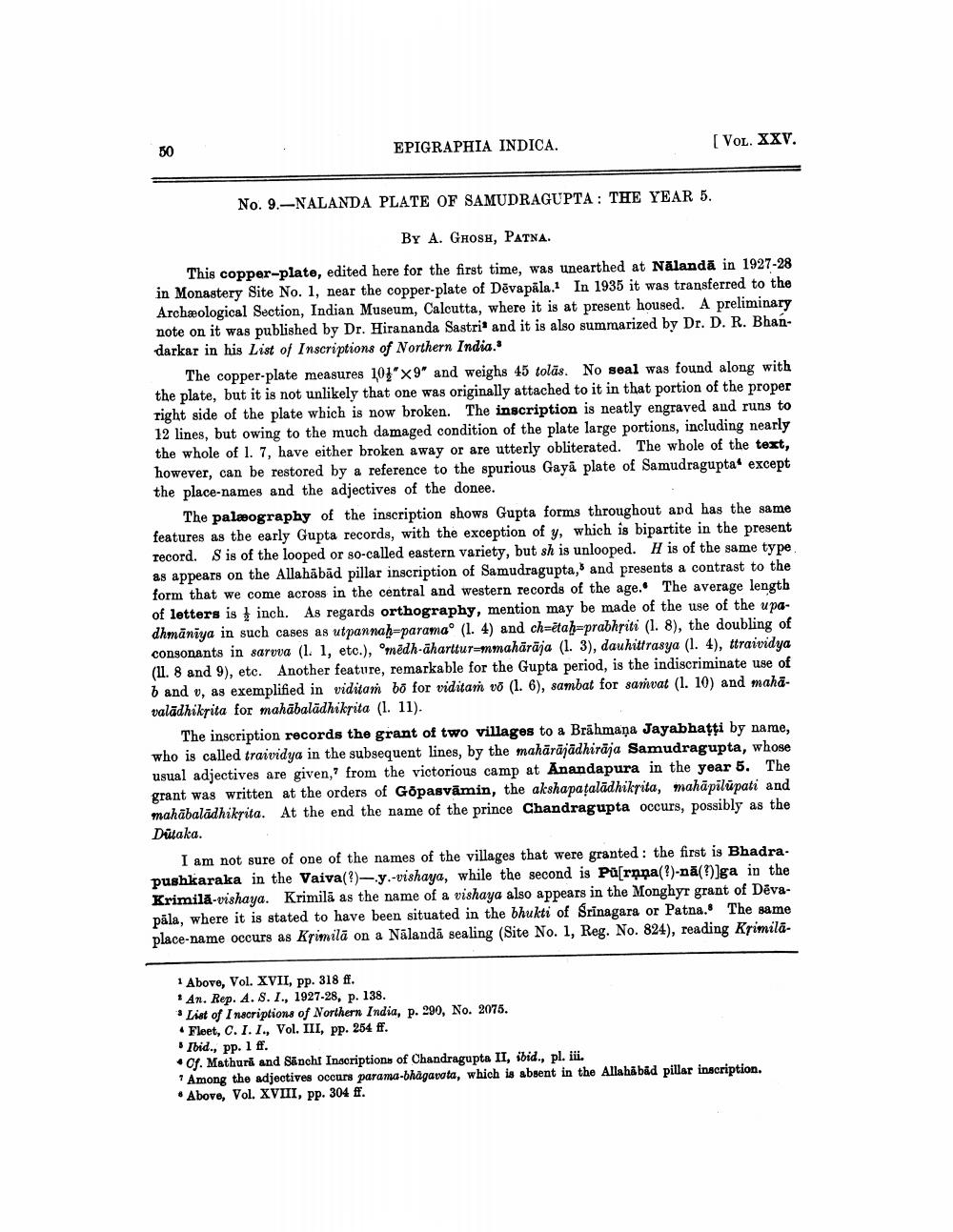________________
EPIGRAPHIA INDICA.
(VOL. XXV.
No. 9.-NALANDA PLATE OF SAMUDRAGUPTA : THE YEAR 5.
BY A. GHOSH, PATNA.
This copper-plate, edited here for the first time, was unearthed at Nālandā in 1927-28 in Monastery Site No. 1, near the copper-plate of Dēvapāla. In 1935 it was transferred to the Archæological Section, Indian Museum, Calcutta, where it is at present housed. A preliminary note on it was published by Dr. Hirananda Sastri and it is also summarized by Dr. D. R. Bhandarkar in his List of Inscriptions of Northern India.
The copper-plate measures 101" x 9" and weighs 45 tolas. No seal was found along with the plate, but it is not unlikely that one was originally attached to it in that portion of the proper right side of the plate which is now broken. The inscription is neatly engraved and runs to 12 lines, but owing to the much damaged condition of the plate large portions, including nearly the whole of 1.7, have either broken away or are utterly obliterated. The whole of the text, however, can be restored by a reference to the spurious Gayā plate of Samudragupta except the place-names and the adjectives of the donee.
The palæography of the inscription shows Gupta forms throughout and has the same features as the early Gupta records, with the exception of y, which is bipartite in the present Tecord. S is of the looped or so-called eastern variety, but sh is unlooped. His of the same type as appears on the Allahābād pillar inscription of Samudragupta, and presents a contrast to the form that we come across in the central and western records of the age. The average length of letters is inch. As regards orthography, mention may be made of the use of the upadhmāniya in such cases as utpannah-paramao (1. 4) and ch=ētah=prabhsiti (1. 8), the doubling of consonants in saruva (1. 1, etc.), Omëdh-aharttur=mmahārāja (1. 3), dauhittrasya (1. 4), ttraividya (11. 8 and 9), etc. Another feature, remarkable for the Gupta period, is the indiscriminate use of b and v, as exemplified in viditam bo for viditam vo (1. 6), sambat for sarvat (1. 10) and manavalādhikrita for mahābalādhikrita (1. 11).
The inscription records the grant of two villages to a Brähmana Jayabhatti by name, who is called traividya in the subsequent lines, by the mahārājādhirāja Samudragupta, whose usual adjectives are given, from the victorious camp at Anandapura in the year 5. The grant was written at the orders of Gopasvāmin, the akshapatalādhikrita, mahāpīlūpati and mahābalādhikrita. At the end the name of the prince Chandragupta occurs, possibly as the Dutaka.
I am not sure of one of the names of the villages that were granted: the first is Bhadrapushkaraka in the Vaiva(?)- y.-vishaya, while the second is Pa[rpna(?)-nā()]ga in the Krimila-vishaya. Krimila as the name of a vishaya also appears in the Monghyr grant of Dévapāla, where it is stated to have been situated in the bhukti of Srinagara or Patna. The same place-name occurs as Krimilā on a Nalandă sealing (Site No. 1, Reg. No. 824), reading Krimila
1 Above, Vol. XVII, pp. 318 ff. *An. Rep. A. S.I., 1927-28, p. 138. List of Inscriptions of Northern India, p. 290, No. 2075. Fleet, C.I.I., Vol. III, pp. 254 ff.
Ibid., pp. 1 ff. • Of. Mathuri and Sanchi Inscriptions of Chandragupta II, ibid., pl. ii. * Among the adjectives occurs parama-bhagavata, which is absent in the Allahabad pillar inscription. • Above, Vol. XVIII, pp. 304 ff.




